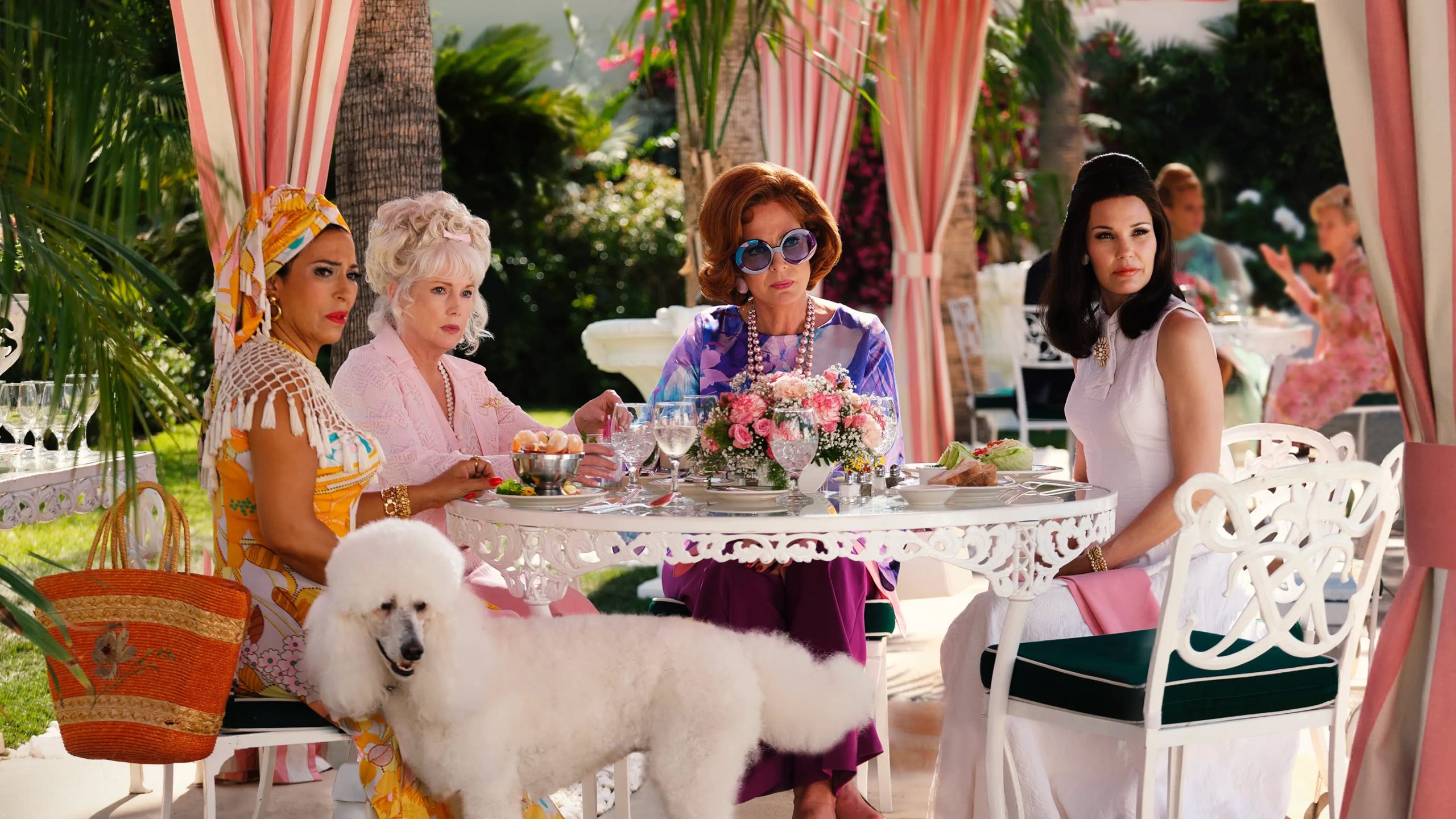The haves and the have-mores.
What fills out the cobalt-skyed landscape in the new AppleTV+ dramedy Palm Royale, starring one Kristen Wiig as Maxine, a Tennessee also-ran pageant queen with one very specific mission: to conquer Palm Beach society. Set in the final gasp of the 1960s – Richard Nixon in the White House, Neil Armstrong on the moon – and mired along that 16-mile creme-de-la-creme stretch of Florida coastline, it is a pastel-coloured swimming pool floatie of a show. Think: trophy wives, sugar daddies, society queens and pool boys.
“Crabs in a barrel:” the way Wiig’s character sums up the “season” that is cracking on in the town, later referring to “the rise and fall of social stocks, the cementing and undoing of legacies…so much promise, so much peril.” Palm Beach is the last American sanctuary, as Allison Janney’s character – a maxi-clad queen bee declares in the first episode of the 10-part series, hinting at the mores of a place that, by the 1960s, had long been going as a playground of the super-rich.

The lavish sets of Palm Royale transport viewers to the glamorous Palm Beach of 1969. Photo: Apple TV
Vanderbilts and Rockefellers. Morgans, Mellons, Gettys and Carnegies. N’est-pas? A place in the jungle that rose out of nothing when Henry Morrison Flager, a partner in Standard Oil, built a railroad down the eastern coast of Florida, at which point he started envisioning the Royal Poinciana, (the first fully electrified hotel in the world in 1894). Later, even, another hotel that was destined to become The Breakers, a still-going grande-dame that, at the time, had a railroad link that carried passengers right up to its door, could count a cigar-accessorized Mark Twain strolling around in its splendorous midst and, overnight, became a kind of American Riviera for the glossy set.
Famously, three drawbridges link Palm Beach to the mainland (which can be raised in a matter of minutes and has caused some to quip that it was arguably the first gated community in America). “Twenty-five percent of the capital wealth of the United States is sitting in Palm Beach during the season,” claimed a Wall Street financier about the enclave many years later, in 2004, in Vanity Fair. Both of which help to setup such fodder – and satire – for the antics in Palm Royale.

Allison Janney in “Palm Royale,” premiering March 20, 2024 on Apple TV+
Especially since the show is set in a particular heyday of the place, a bullseye of a time when things were much less porous between Old Money and New, cereal heiress Marjorie Merriweather Post still owned her beloved Mar-a-Lago, and photographer Slim Aarons was in the thrust of mythologizing the place with his now-famous pics (socialite CZ Guest et al at play).
Charity begins at home? So, Wiig as Maxine discovers when she sets off on her mission to invade the philanthropic scene in these parts – complete with her Twiggy dresses, and Golightly updo, an old-school Grasshopper cocktail never far from reach. Part of an all-star cast (this show has everyone from Ricky Martin to Laura Dern to even Carol Burnett!), her efforts to get admitted to a particular members club smack of a very high-stakes plot, Palm Beach-style.

Ricky Martin, Amber Chardae Robinson, Laura Dern and Carol Burnett in “Palm Royale”. Photo: Apple TV
Is the club in Palm Royale a stand-in, perhaps, for The Everglades Club, built in 1918 by entrepreneur Addison Mizner and his partner, Paris Singer, of the sewing machine dynasty? Imagined like a medieval palace, complete with Moorish tower, the spot grew in popularity, filling the place up with people with only one credential: they had to be not boring.
Notably, a rival real-life club rose in the late 1920s, commissioned, as it happens by Merriweather Post, across from her vast Mar-a-Lago estate (where she lived for six decades, and kept a 39-member household). The Bath and Tennis (B&T) is what it was called. In those years, the socially prominent included a number of German American Jews – at both clubs – but in the years following the Second World War, they both closed their doors to anyone Jewish (CZ Guest once telling the story of how she and her husband were suspended from the Everglades for having Jewish guests at their 25th-anniversary party).
Another significant take-away from the new series: how “Palm Beach increasingly became a matriarchy,” as historian Laurence Learner has shrewdly observed. “Driven by the wives or widows of fabulously wealthy women…sober matrons overseeing the traditional social life of the island.”
But how much of yourself are you willing to sacrifice to get what someone else has? That is the question that Palm Royale ultimately asks in this Liliy Pulitzer-decked series based loosely on Juliet McDaniel’s novel Mr. and Mrs. Pie. In doing so, it splits the difference between farce and period piece. Like a Sunshine State Saltburn, with some of the most ’60s mid-century modernism that made Men Men fly, it also works as a kind of zeitgeisty companion piece to the other who’s-who series, Feud: Capote vs. the swans. Different flock; same cut-throat ambition and social Darwinism.
The first three episodes of Palm Royale premiere on AppleTV+ on March 20








